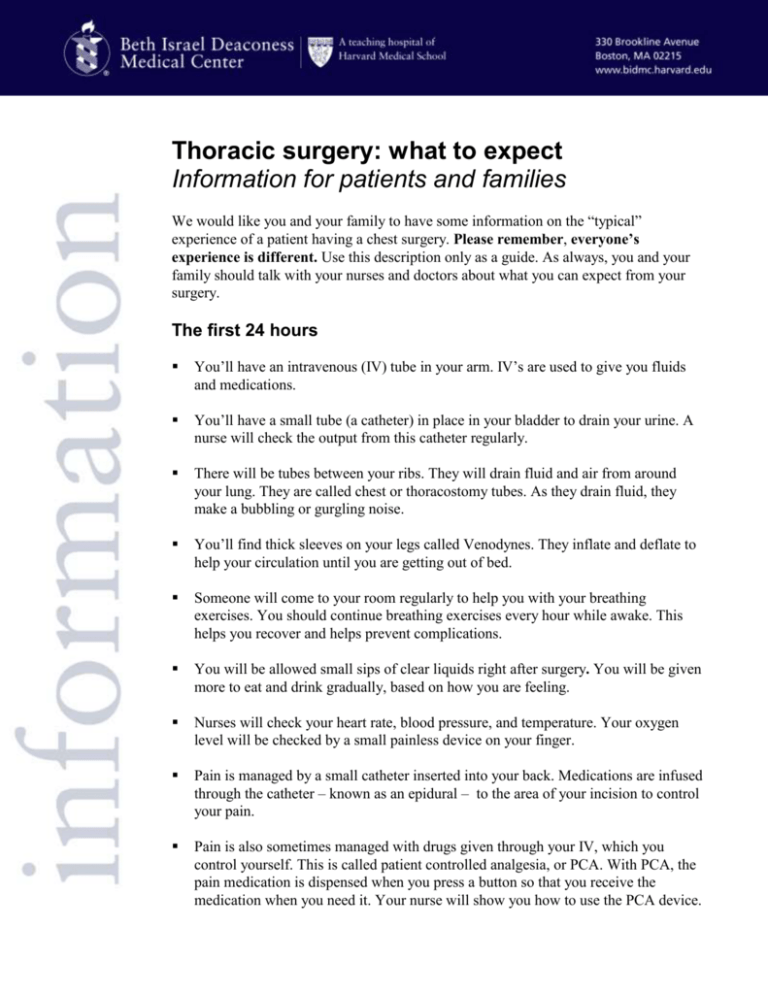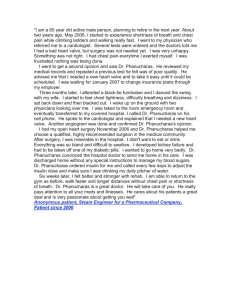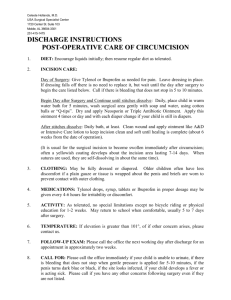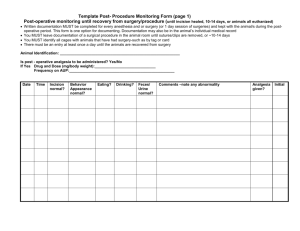
Thoracic surgery: what to expect
Information for patients and families
We would like you and your family to have some information on the “typical”
experience of a patient having a chest surgery. Please remember, everyone’s
experience is different. Use this description only as a guide. As always, you and your
family should talk with your nurses and doctors about what you can expect from your
surgery.
The first 24 hours
You’ll have an intravenous (IV) tube in your arm. IV’s are used to give you fluids
and medications.
You’ll have a small tube (a catheter) in place in your bladder to drain your urine. A
nurse will check the output from this catheter regularly.
There will be tubes between your ribs. They will drain fluid and air from around
your lung. They are called chest or thoracostomy tubes. As they drain fluid, they
make a bubbling or gurgling noise.
You’ll find thick sleeves on your legs called Venodynes. They inflate and deflate to
help your circulation until you are getting out of bed.
Someone will come to your room regularly to help you with your breathing
exercises. You should continue breathing exercises every hour while awake. This
helps you recover and helps prevent complications.
You will be allowed small sips of clear liquids right after surgery. You will be given
more to eat and drink gradually, based on how you are feeling.
Nurses will check your heart rate, blood pressure, and temperature. Your oxygen
level will be checked by a small painless device on your finger.
Pain is managed by a small catheter inserted into your back. Medications are infused
through the catheter – known as an epidural – to the area of your incision to control
your pain.
Pain is also sometimes managed with drugs given through your IV, which you
control yourself. This is called patient controlled analgesia, or PCA. With PCA, the
pain medication is dispensed when you press a button so that you receive the
medication when you need it. Your nurse will show you how to use the PCA device.
Continuing your recovery
Activity
You will begin to get back on your feet as soon as the day of surgery. You’ll be
encouraged to participate in an activity program several times a day. Although the
program is different for everyone, most patients follow this kind of schedule:
Day one – Walk in the hall with help two–three times. Sit up in chair for all
meals.
Day two – Walk three times in the in the hall. Sit up in chair for all meals.
By the time you go home you should be walking comfortably both in the hall and on
the stairs. You’ll be restricted from lifting anything greater than 10 pounds for 4- 6
weeks depending on the type of incision you have.
Ask your doctor when you may expect to drive or return to work, school, or other
activities. This is different for everyone.
Diet
You will be able to start drinking some fluid on the day of surgery. You will eat and
drink a little more each day after that. You’ll need to take it slowly. You may not
feel like eating much. This is normal.
Pain Management
You will continue to receive pain medication through the catheter in your back or
the PCA pump until the chest tubes are removed.
When the tubes are removed from your chest, you’ll be switched to pills for pain
control.
Incisions
Depending on the type of surgery you have, you may have one large incision from
the back to the side of your chest (open thoracotomy), a smaller incision on the side
(mini-thoracotomy), or several very small incisions (video assisted thoracic surgery,
or VATS). Your surgeon will tell you what kind of incision to expect.
The dressing over your surgical incision will be removed and left open to air after
the second day. The health care team will inspect it daily.
You will have a dressing over the site where your chest tube was inserted. Once the
chest tube is removed, this dressing stays in place for 48 hours.
You’ll be able to shower once all the dressings are removed.
Drains
The catheter in your bladder will be removed when you are able to get up and
around.
The IV tube will remain in place until you are discharged.
The chest tubes are removed based on how your recovery is progressing. This varies
from patient to patient.
Before discharge...Getting ready to go home
Now is the time to start thinking about what you’ll need after you go home. Our case
managers and social workers are available to help you and your family if needed. We
also recommend you watch Good Questions about Going Home, which airs several
times a day on the medical center’s Care!TV, channel 35.
As your day of discharge nears, you can expect the following in your routine:
Your breathing exercises continue every hour.
You’ll be up in the chair most of the day, and you’ll walk in the hall at least three–
four times a day for 5-10 minutes.
You’ll be able to sit or stand by the sink and bathe yourself without help.
You will be eating regular food.
Your nurses will teach you about things to expect after surgery. They will make sure
you and your family understand how to take care of any problem.
You will receive a schedule of all your follow-up appointments and blood tests.
We hope this brochure helps you and your family know what to expect when you come
for your surgery. If there is anything you don’t understand, please ask your doctors and
nurses. We want to make sure your stay is as safe and comfortable as possible.
This material was prepared by clinicians from the departments of surgery and nursing at Beth Israel Deaconess Medical Center. It is
produced and distributed by The Beth Israel Deaconess Learning Center. ©2005, Beth Israel Deaconess Medical Center. All rights
reserved. MC0973 01/05







